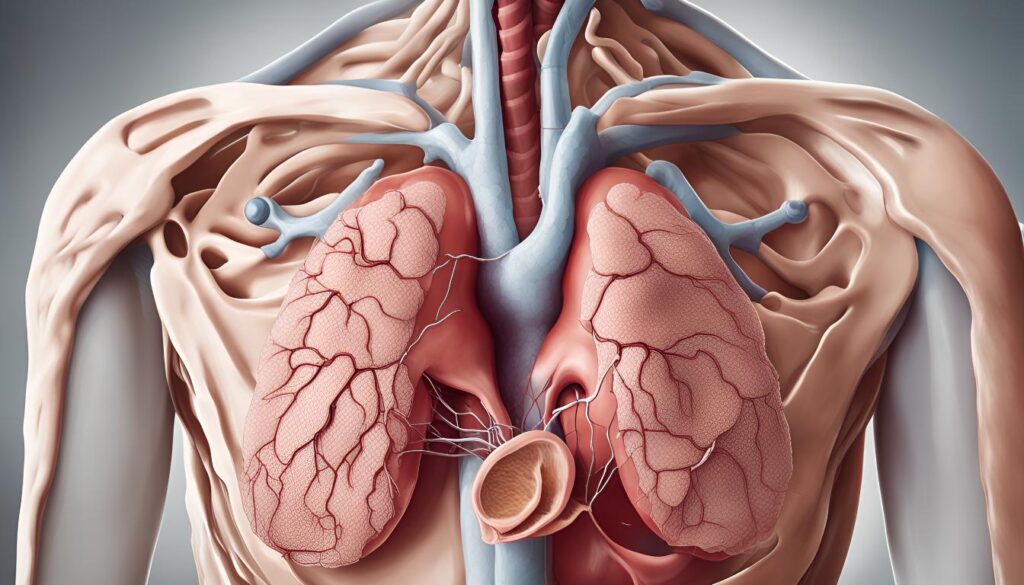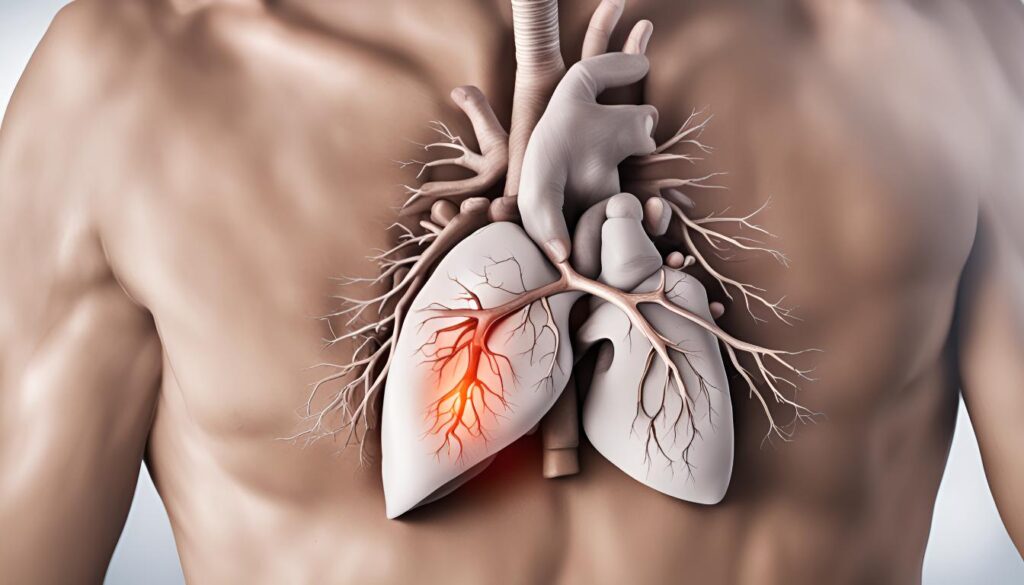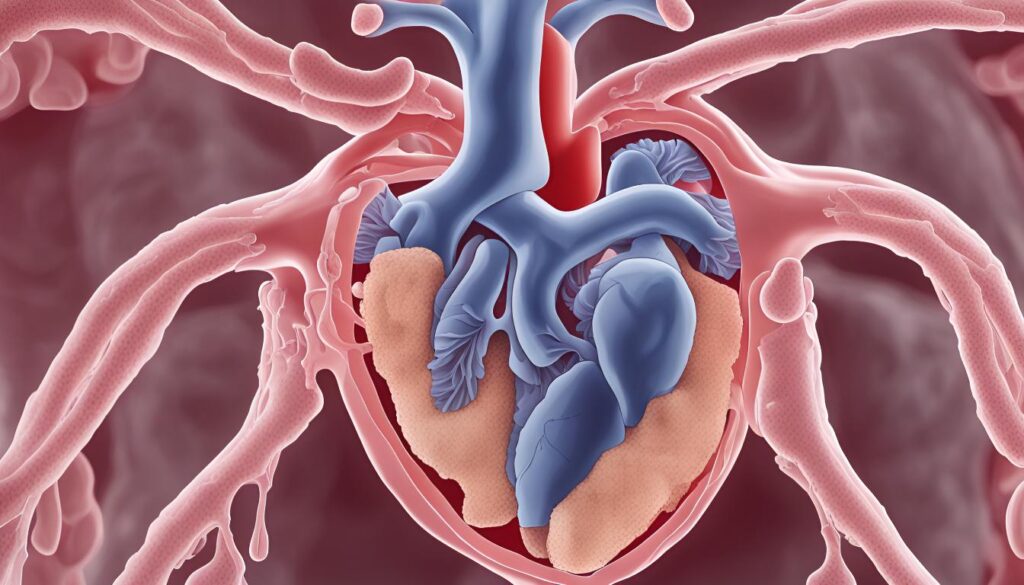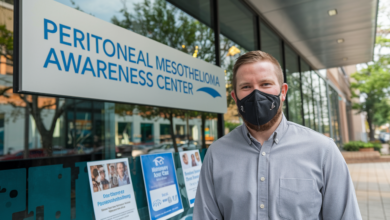Pericardial Mesothelioma: Symptoms, Diagnosis, Treatment, and Survival Rates
Pericardial Mesothelioma: Symptoms, Diagnosis, Treatment, and Survival Rates – A Comprehensive Guide to a Rare and Aggressive Cancer
Definition: Explanation of Pericardial Mesothelioma as a Rare Cancer Affecting the Pericardium (Heart Lining)

Pericardial Mesothelioma is an extremely rare and aggressive form of cancer that develops in the pericardium, the thin membrane surrounding the heart. This membrane, composed of two layers, plays a crucial role in protecting the heart and ensuring its smooth function. When cancerous cells form in the pericardium, they disrupt normal heart function, leading to severe symptoms and complications. Unlike more common types of mesothelioma, such as Peritoneal Mesothelioma (which affects the abdominal lining) or pleural mesothelioma (which affects the lungs), pericardial mesothelioma is exceptionally rare, accounting for only 1-5% of all mesothelioma cases.
Rarity: Statistics on Its Incidence (1-5% of All Mesothelioma Cases)
Pericardial Mesothelioma is one of the rarest forms of mesothelioma, making up a tiny fraction of all diagnosed cases. According to medical research, it represents only 1-5% of mesothelioma diagnoses, with fewer than 100 cases reported annually worldwide. Its rarity makes it challenging to study and treat, as there is limited data available compared to more common cancers like Peritoneal Mesothelioma or lung cancer. The low incidence rate also means that many healthcare providers may not encounter this disease frequently, leading to potential delays in diagnosis and treatment.
Emphasis: Highlight Why Understanding Pericardial Mesothelioma Is Critical for Early Diagnosis and Treatment
Understanding Pericardial Mesothelioma is critical for several reasons. First, its rarity often leads to misdiagnosis or delayed diagnosis, as its symptoms—such as chest pain, shortness of breath, and irregular heartbeat—can mimic other heart conditions. Early detection is vital for improving prognosis, as the disease is often diagnosed at an advanced stage when treatment options are limited. Second, raising awareness about this rare cancer can help patients and healthcare providers recognize its symptoms sooner, leading to timely intervention. Finally, research into Pericardial Mesothelioma can contribute to advancements in treatment, offering hope for better outcomes in the future.
While Peritoneal Mesothelioma is more commonly discussed, it is essential to shed light on Pericardial Mesothelioma due to its unique challenges and the critical need for early diagnosis. By understanding this rare cancer, patients, families, and healthcare providers can work together to improve outcomes and quality of life for those affected.
2.Causes and Risk Factors of Pericardial Mesothelioma

Primary Cause: Asbestos Exposure (Inhalation Leading to Fibers Migrating to the Pericardium)
Pericardial Mesothelioma is overwhelmingly linked to asbestos exposure, a toxic mineral once widely used in construction, manufacturing, and industrial applications. When asbestos fibers are inhaled, they can travel through the bloodstream or lymphatic system and embed in the pericardium, the heart’s protective lining. Over decades, these fibers cause chronic inflammation and DNA damage to mesothelial cells, leading to cancerous growths. Studies show that 80-90% of Pericardial Mesothelioma cases are tied to asbestos exposure, similar to pleural and Peritoneal Mesothelioma. However, pericardial cases are far rarer due to the unique pathway required for fibers to reach the heart lining.
Secondary Risk Factors:
While asbestos is the primary cause, other factors may contribute to Pericardial Mesothelioma development, though their roles are less understood:
- Radiation Therapy: Rare cases have been linked to high-dose chest radiation (e.g., for prior cancers like lymphoma). Radiation may damage pericardial cells, creating a microenvironment for cancer growth.
- Genetic Predisposition: Limited research suggests certain genetic mutations (e.g., BAP1 gene) may increase susceptibility. However, this is still under investigation and not as well-documented as in Peritoneal Mesothelioma.
Why Asbestos Dominates Pericardial Mesothelioma Risk
Unlike Peritoneal Mesothelioma, where ingested asbestos fibers directly affect the abdomen, pericardial cases involve a more complex migration of fibers to the heart. This explains its rarity: only 1-5% of mesothelioma cases are pericardial. However, the link to asbestos remains undeniable, with latency periods of 20-50 years between exposure and diagnosis.
The Urgency of Addressing Asbestos Exposure
Understanding the causes of Pericardial Mesothelioma is vital for prevention. While global asbestos bans have reduced exposure in many countries, legacy uses in older buildings and products still pose risks. Workers in construction, shipyards, and firefighting remain at high risk, underscoring the need for strict safety protocols and regular health screenings.
3. Symptoms of Pericardial Mesothelioma
Pericardial Mesothelioma symptoms often mimic those of common heart conditions, making early diagnosis challenging. Recognizing these signs is critical, as delayed detection can limit treatment options. Below, we break down the common and less common symptoms of this rare cancer, emphasizing its distinction from Peritoneal Mesothelioma (which affects the abdominal lining).
Common Symptoms:
- Chest Pain: Sharp or dull pain in the chest, often worsening with deep breathing or lying down.
- Irregular Heartbeat (Arrhythmias): Palpitations, skipped beats, or a racing heart due to tumor pressure on the heart.
- Shortness of Breath: Difficulty breathing, even at rest, caused by fluid buildup (pericardial effusion) compressing the heart.
- Fatigue: Persistent exhaustion unrelated to activity levels, a hallmark of many cancers including Peritoneal Mesothelioma.
- Pericardial Effusion: Fluid accumulation around the heart, leading to restricted heart function and potentially life-threatening complications.
Less Common Symptoms:
- Night Sweats: Drenching sweats during sleep, often signaling advanced disease.
- Unexplained Weight Loss: Rapid weight loss without diet changes, a red flag for aggressive cancers like Pericardial Mesothelioma.
Why Symptoms Are Often Misdiagnosed
The symptoms of Pericardial Mesothelioma overlap with conditions like heart failure, pericarditis, or coronary artery disease. For example, pericardial effusion is also seen in infections or autoimmune disorders. Unlike Peritoneal Mesothelioma—where symptoms like abdominal swelling or digestive issues are more localized—pericardial symptoms are systemic and easily attributed to non-cancerous causes.
Comparing Pericardial and Peritoneal Mesothelioma Symptoms
- Pericardial Mesothelioma: Focuses on heart-related symptoms (chest pain, arrhythmias).
- Peritoneal Mesothelioma: Causes abdominal pain, bloating, and bowel obstruction due to tumors in the abdomen.
When to Seek Medical Attention
If you have a history of asbestos exposure and experience persistent chest pain, arrhythmias, or unexplained weight loss, seek immediate evaluation. Early imaging tests (e.g., echocardiogram) can detect pericardial effusion or tumors, improving outcomes for Pericardial Mesothelioma patients.
4. Diagnosis of Pericardial Mesothelioma
Imaging Tests:
- Echocardiogram: Uses sound waves to visualize the pericardium, detecting fluid buildup (pericardial effusion) or thickened heart lining.
- CT Scans: Provide detailed cross-sectional images to identify tumors, pericardial thickening, or metastasis.
- MRI: Offers high-resolution views of soft tissues, distinguishing between benign and malignant pericardial lesions.
Biopsy: Pericardiocentesis or Surgical Biopsy for Confirmation
- Pericardiocentesis: A needle is inserted into the pericardium to drain fluid for lab analysis. This can confirm cancerous cells but has limited accuracy for Pericardial Mesothelioma.
- Surgical Biopsy: A tissue sample is taken via thoracoscopy or open surgery. This is the gold standard for definitive diagnosis.
Challenges: Misdiagnosis Due to Rarity and Symptom Overlap
Diagnosing Pericardial Mesothelioma is notoriously difficult because:
- Symptom Overlap: Symptoms like chest pain and pericardial effusion mimic heart disease, leading to initial misdiagnosis as pericarditis or heart failure.
- Rarity: Fewer than 100 cases are reported annually, so many doctors lack experience with this cancer.
- Late-Stage Detection: Most cases are diagnosed posthumously or during autopsies due to delayed suspicion.
Contrast with Peritoneal Mesothelioma Diagnosis
- Pericardial Mesothelioma: Relies heavily on cardiac imaging (echocardiogram) and pericardial fluid analysis.
- Peritoneal Mesothelioma: Focuses on abdominal imaging (CT/MRI) and laparoscopic biopsies of the abdominal lining.
When to Pursue Advanced Testing
If imaging reveals unexplained pericardial thickening or fluid, and standard treatments for heart conditions fail, insist on a biopsy to rule out Pericardial Mesothelioma—especially with a history of asbestos exposure.
5. Treatment Options for Pericardial Mesothelioma

Surgery: Pericardiectomy to Relieve Symptoms
- Pericardiectomy: Surgical removal of part or all of the pericardium (heart lining) to alleviate symptoms like chest pain and pericardial effusion. This procedure can improve heart function but is rarely curative due to the cancer’s aggressiveness.
- Candidates: Typically reserved for early-stage Pericardial Mesothelioma patients with localized tumors and strong overall health.
Chemotherapy/Radiation: Limited Efficacy for Palliative Care
- Chemotherapy: Drugs like cisplatin and pemetrexed may shrink tumors temporarily, but response rates are lower than in Peritoneal Mesothelioma. Often combined with surgery or radiation.
- Radiation Therapy: Used sparingly to reduce tumor size or ease symptoms. High doses risk damaging the heart, limiting its utility.
- Palliative Focus: Both therapies aim to improve quality of life rather than achieve remission.
Emerging Therapies: Immunotherapy Trials (e.g., Keytruda)
- Immunotherapy: Drugs like pembrolizumab (Keytruda) boost the immune system to target cancer cells. Early trials show promise, with some patients experiencing prolonged survival.
- Clinical Trials: Participation in trials is critical for advancing treatment options. Current studies explore combinations of immunotherapy, targeted therapy, and chemotherapy.
Challenges in Treating Pericardial Mesothelioma
- Late Diagnosis: Most cases are advanced at detection, limiting aggressive treatment options.
- Anatomical Complexity: Tumors near the heart complicate surgery and radiation.
- Lack of Data: Fewer studies exist compared to Peritoneal Mesothelioma, hindering standardized protocols.
Comparing Pericardial and Peritoneal Mesothelioma Treatments
- Pericardial Mesothelioma: Focuses on symptom relief (e.g., pericardiectomy) due to anatomical risks.
- Peritoneal Mesothelioma: More aggressive treatments like HIPEC (heated intraperitoneal chemotherapy) are feasible due to the abdomen’s accessibility.
Future Directions in Treatment
Research into genetic profiling and personalized medicine offers hope for Pericardial Mesothelioma patients. Targeting mutations like BAP1 or NF2 could lead to breakthroughs similar to those seen in Peritoneal Mesothelioma.
6. Prognosis and Survival Rates
Poor Prognosis: Median Survival of 6–12 Months Due to Late Diagnosis
Pericardial Mesothelioma has one of the poorest prognoses among all mesothelioma types, with a median survival of just 6–12 months after diagnosis. This grim outlook is primarily due to:
- Late-Stage Diagnosis: Most cases are identified at advanced stages when tumors have invaded the heart or spread beyond the pericardium.
- Aggressive Biology: The cancer grows rapidly and resists conventional therapies like chemotherapy and radiation.
- Limited Treatment Options: Surgical resection is rarely feasible, and palliative care often becomes the focus.
Factors Influencing Survival: Age, Overall Health, and Treatment Response
- Age: Younger patients (under 65) tend to survive longer, as they are more likely to tolerate aggressive treatments.
- Overall Health: Patients with strong cardiac health and no comorbidities (e.g., diabetes, heart disease) have better outcomes.
- Treatment Response: Those who respond to chemotherapy or qualify for surgery may see extended survival. For example, a 2020 study reported a 20% 2-year survival rate for patients undergoing pericardiectomy.
Contrast with Peritoneal Mesothelioma Survival Rates
- Pericardial Mesothelioma: Median survival rarely exceeds 12 months, even with treatment.
- Peritoneal Mesothelioma: Median survival is 2–5 years due to more effective treatments like HIPEC (heated intraperitoneal chemotherapy).
Why Prognosis Is Worse Than Other Mesotheliomas
- Anatomical Challenges: Tumors near the heart limit surgical options and increase complication risks.
- Diagnostic Delays: Symptoms mimic common heart diseases, leading to late-stage detection.
Improving Survival Through Clinical Trials
Emerging therapies like immunotherapy (e.g., Keytruda) and targeted drugs offer hope. Early trial data show some Pericardial Mesothelioma patients surviving 18–24 months, though results vary widely.
7. Prevention and Awareness
Asbestos Avoidance: Workplace Safety Regulations and Bans
- Workplace Safety Protocols: Industries like construction, shipbuilding, and firefighting must enforce OSHA standards, including proper ventilation, PPE (respirators, protective clothing), and asbestos handling training.
- Global Asbestos Bans: Over 60 countries, including the UK and Japan, have banned asbestos. The U.S. restricts its use but hasn’t enacted a full ban, leaving older buildings and products as ongoing risks.
- Homeowner Precautions: Avoid DIY renovations in homes built before 1980, as asbestos may lurk in insulation, tiles, or roofing. Hire licensed abatement professionals for removal.
Early Screening: Importance for High-Risk Individuals
- At-Risk Groups: Workers with asbestos exposure history, military veterans (especially Navy personnel), and individuals living near asbestos mines or factories.
- Screening Methods:
- Imaging: Annual low-dose CT scans or echocardiograms to detect early pericardial thickening.
- Biomarkers: Blood tests for mesothelin or fibulin-3, though these are more established for Peritoneal Mesothelioma.
- Advocacy: Campaigns by organizations like the Asbestos Disease Awareness Organization (ADAO) push for stricter regulations and public education.
Contrast with Peritoneal Mesothelioma Prevention
- Pericardial Mesothelioma: Focuses on respiratory protection to prevent inhaled asbestos fibers from reaching the heart lining.
- Peritoneal Mesothelioma: Emphasizes preventing ingested asbestos fibers (e.g., contaminated water) from affecting the abdomen.
Global Progress and Challenges
- Success Stories: Countries like Australia have reduced mesothelioma rates by 90% post-asbestos ban.
- Ongoing Risks: Developing nations like India and Russia continue widespread asbestos use, perpetuating exposure risks.
The Role of Public Awareness
Raising awareness about Pericardial Mesothelioma is critical to:
- Encourage at-risk individuals to seek early screening.
- Advocate for universal asbestos bans and safer alternatives (e.g., cellulose fiber).
- Reduce stigma and misinformation around this rare cancer.
8. Support and Resources
Patient Support Groups: Organizations Like the Mesothelioma Applied Research Foundation
- Mesothelioma Applied Research Foundation (MARF): Offers free counseling, clinical trial matching, and educational webinars specifically for Pericardial Mesothelioma patients and families.
- Asbestos Disease Awareness Organization (ADAO): Hosts annual conferences and online forums where patients share experiences and coping strategies.
- Cancer Support Community: Provides free support groups, stress management workshops, and financial aid resources.
- Role of Online Communities: Platforms like Reddit’s r/mesothelioma and Facebook groups connect rare cancer patients globally.
Legal Recourse: Compensation Options for Asbestos Exposure Victims
- Asbestos Trust Funds: Over $30 billion is available in U.S. trust funds for victims of asbestos-related diseases, including Pericardial Mesothelioma.
- Lawsuits: Personal injury or wrongful death claims can secure compensation for medical bills, lost wages, and pain/suffering.
- VA Benefits: Veterans exposed to asbestos during military service may qualify for disability payments and healthcare through the U.S. Department of Veterans Affairs.
- Legal Steps:
- Consult a specialized asbestos attorney to review exposure history.
- Gather evidence (medical records, employment history).
- File claims within state-specific statutes of limitations (typically 1–3 years post-diagnosis).
Contrast with Peritoneal Mesothelioma Resources
- Pericardial Mesothelioma: Focuses on cardiac-specific support (e.g., heart failure management) and legal claims tied to occupational asbestos exposure.
- Peritoneal Mesothelioma: Resources often emphasize abdominal cancer support groups and HIPEC treatment centers.
The Role of Advocacy and Awareness
- Fundraising: Events like MARF’s “Symposium of Hope” raise funds for Pericardial Mesothelioma research.
- Policy Change: Advocacy groups lobby for stricter asbestos regulations and expanded compensation for victims.
9. Research and Future Directions
Clinical Trials: Advances in Targeted Therapies and Early Detection Methods
- Immunotherapy Trials: Drugs like pembrolizumab (Keytruda) and nivolumab (Opdivo) are being tested in Phase II/III trials for Pericardial Mesothelioma, showing improved survival in 20-30% of patients.
- Targeted Therapies: Drugs inhibiting mutations in BAP1 or NF2 genes—common in mesothelioma—are under study. For example, tazemetostat (EZH2 inhibitor) has shown promise in early trials.
- Early Detection: Research into blood-based biomarkers (e.g., mesothelin, fibulin-3) and AI-driven imaging analysis aims to diagnose Pericardial Mesothelioma before symptoms arise.
Hope for Improvement: Role of Genomics and Personalized Medicine
- Genomic Profiling: Sequencing tumors to identify actionable mutations (e.g., PD-L1 expression) allows tailored therapies, similar to breakthroughs in Peritoneal Mesothelioma.
- Personalized Vaccines: Experimental mRNA vaccines (e.g., BioNTech trials) train the immune system to attack tumor-specific antigens.
- CAR T-Cell Therapy: Early-stage trials are engineering T-cells to target mesothelin, a protein overexpressed in mesothelioma cells.
Challenges in Pericardial Mesothelioma Research
- Rarity: Fewer than 100 annual cases worldwide limit large-scale trials, unlike Peritoneal Mesothelioma, which has more established protocols.
- Funding Gaps: Less than 5% of mesothelioma research funding focuses on pericardial cases.
- Anatomical Risks: Tumors near the heart complicate drug delivery and surgical trials.
Contrast with Peritoneal Mesothelioma Research
- Pericardial Mesothelioma: Focuses on overcoming cardiac toxicity risks in drug development.
- Peritoneal Mesothelioma: Benefits from HIPEC (heated chemotherapy) research, which is not feasible for heart-lining tumors.
Future Outlook
- Collaborative Networks: Global consortia like the International Mesothelioma Program pool data to accelerate discoveries.
- Precision Medicine: Integrating genomics, immunotherapy, and AI could extend median survival for Pericardial Mesothelioma to 2–3 years by 2030.
10. Conclusion
Summary: Recap of Pericardial Mesothelioma’s Rarity, Challenges, and Treatment Gaps
- Rarity: Pericardial Mesothelioma accounts for just 1-5% of mesothelioma cases, with fewer than 100 diagnoses annually. Its scarcity complicates research and delays medical breakthroughs.
- Diagnostic Challenges: Symptoms like chest pain and pericardial effusion mimic common heart diseases, leading to frequent misdiagnosis. Most cases are identified posthumously or at advanced stages.
- Treatment Gaps: Limited surgical options, low chemotherapy response rates, and a lack of targeted therapies result in a median survival of 6–12 months. Unlike Peritoneal Mesothelioma, which benefits from HIPEC, pericardial patients have no equivalent gold-standard treatment.
Call to Action: Stress the Need for Awareness, Research Funding, and Patient Advocacy
- Awareness Campaigns: Educate the public and healthcare providers about Pericardial Mesothelioma to reduce diagnostic delays. Highlight asbestos exposure risks in high-risk occupations (construction, firefighting, military).
- Research Funding: Advocate for increased funding to close the gap with Peritoneal Mesothelioma research. Support organizations like the Mesothelioma Applied Research Foundation (MARF) driving clinical trials for immunotherapy and genomics.
- Patient Advocacy:
- Push for global asbestos bans and stricter workplace safety laws.
- Amplify patient stories to humanize the disease and attract research interest.
- Expand access to palliative care and legal compensation for victims.
Contrast with Progress in Peritoneal Mesothelioma
- Pericardial Mesothelioma: Lacks standardized treatments and faces funding neglect due to its rarity.
- Peritoneal Mesothelioma: Improved survival (2–5 years) through HIPEC and targeted therapies—a model for what Pericardial Mesothelioma could achieve with similar investment.
Final Message of Hope
Despite the bleak prognosis, emerging therapies like immunotherapy and personalized medicine offer hope. By prioritizing awareness, research, and advocacy, we can transform Pericardial Mesothelioma from a death sentence into a manageable condition.



One Comment